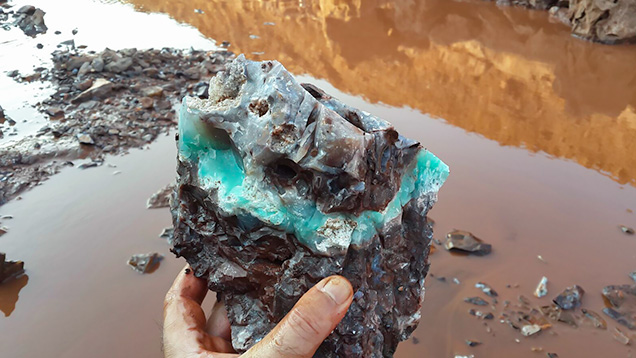A New Natural-Color Bluish Green Chalcedony
 |
| Figure 1. This bluish green chalcedony, colored by chromium and nickel, is marketed under the trade name ?Aquaprase.? Photo by Kevin Schumacher. |
A new type of chalcedony (figure 1) was recently submitted to GIA?s Carlsbad laboratory by Yianni Melas of Greece. According to Melas, this material originated in Africa (figure 2), although a more precise location has not been made available. The translucent material displayed a vibrant bluish green color and is currently marketed under the trade name ?Aquaprase.? Although chalcedony varieties such as chrysoprase and Gem Silica are well known and occur in yellowish green and greenish blue colors, the color of this material was distinctly different from any African chalcedony examined by GIA to date.
 |
|
Figure 2. A large piece of chalcedony rough recovered from the mining area. Photo by Yianni Melas.
|
From a gemological perspective, it was important to conclusively determine that this material was naturally colored and not artificially dyed. Since the quartz crystals present in this material were colorless rather than brown, we ruled irradiation out as a possible treatment. Microscopic examination of rough and cut stones in conjunction with chemical analysis and visible spectroscopy were used to characterize this chalcedony. Standard gemological testing revealed an RI range from 1.531 to 1.539, with no observable birefringence. The SG, measured hydrostatically, ranged from 2.55 to 2.57. A handheld spectroscope revealed faint, narrow lines in the red end of the spectrum, rather than the broadband absorption one would expect if the material had been dyed with an organic pigment. All of these features were consistent with natural-color chalcedony.
Microscopic examination revealed a granular aggregate structure with a few areas showing subtle banding and faint green concentrations of color between some of the coarser quartz grains, which appeared to be a greenish mineral phase located along the grain boundaries. A waxy luster was observed on fractured areas, consistent with an aggregate material. Some areas contained small cavities that were filled with colorless drusy quartz crystals. Dark brown and black inclusions of various metal oxides were also observed scattered throughout most of the samples examined, along with some areas of whitish cloudy inclusions that were not identified
This new type of African chalcedony is easily recognized by its unique composition and absorption spectrum, which is significantly different from the chrysoprase and Gem Silica varieties. The attractive bluish green color of Aquaprase, which may be caused by chromium and nickel, should prove to be a popular and welcome addition to the gem trade.
Note: The above post is reprinted from materials provided by Gemological Institute of America Inc. The original article was written by Nathan Renfro .